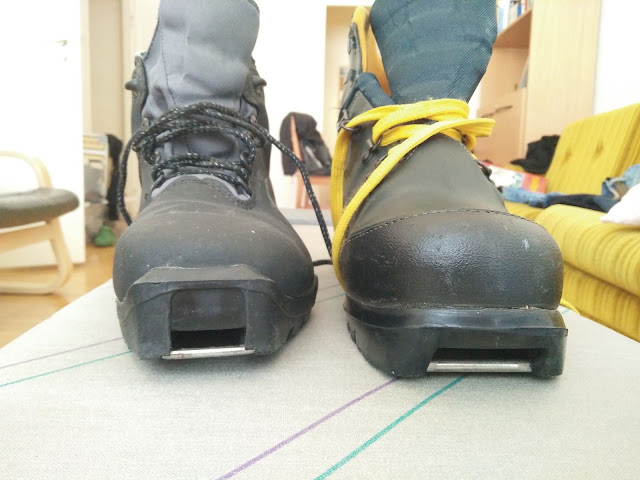Basically the style of XC I do is "classic" which means you propel yourself forward by a combination of "kick" + "stepping into the glide" + "poles"
Firstly, lets look at a video I did some years back on (by todays standards) a crummy camera. Take note of how much the heel lifts and how much the boot needs to move as if on a hinge.
Those are my "off track" skis (they're actually NATO military stuff so they're tough and can take abuse). When I post pictures of my local Ski Track like this:
its been groomed by a machine (snow mobile) towing something flat and heavy to pack down the surface a little (making sking easier) and carve in that pair of grooves, which resembles what you'd experience if you were "off track skiing" in a group (following someone as you do ... because its easier).
The Skis
So, lets look at the difference between "track skis" and "off track skis" ... firstly "track skis" are shorterslimmer
and of course lighter. My track ski weighs 880g while my off track ski weighs 1,780g (yes, nearly 2Kg on each foot, not counting the boot {or any ice you happen to get friendly with}).
This makes skiing the same distance harder work with off track skis (on a track) than track skis (on a track) ... if you have to lift you skis a lot (which you may do on the track when skating a bit) it wears you out a lot ... but the extra with and length means it will carry you over snow which you'd sink into with the track skis, making it easier going in the rough. The off track skis I use also have steel inlays around the edges to make it possible to get some grip on hard packed snow and ice (think spring)...
One needs to be a little careful handling (like storing and transporting) these because that edge is sharp ...
The Boots
On my bindings above (which are New Nordic Norm {a subject unto itself, introduced here}) and there are track and "Back Country" styles ... the BC ones are heavier duty, which becomes clearer when you look at the boots:(... and do ya like my lounge pants?)
and have wider binding mounts and thicker binding Pins (which form the hinge, allowing stepping)
You can see from this shot that the boots are only secured to the binding at the front
and that the binding Pin is much thicker as well as wider ... so one boot will not go onto the other binding.
The boot presses simply onto the binding with a click (well as long as the fucking thing isn't frozen solid with ice, but see that other post) ...
... where the Pin is captured by the front of the binding and held captive in that hole (where the red circle is) by the arrow slider closing over the top of the "cylinder".
Thus the boot is held onto the Ski firmly allowing you to "ski" it forwards, keep good footing (that won't tip on you causing a twisted ankle...) and lift the ski to do stuff like change direction, step over something (like dog shit on the lake ... thanks arseholes) or move around stuff in your way (as happens in the forest when you ski up {yes up !!} a hill)
note the obstacles and uneven terrain ... hard work? Yep ... sure is, but much harder sinkin in to your groin and trying to walk it up or snow shoe up with your shoe getting snow falling in on top of it and having to lift your foot up further with every step...
When its too steep, you can climb by traversing (see the horizontal "lines" up the slope in the below picture) allowing you to keep your feet at a comfortable angle to your legs (unlike snow shoeing) and if you have a decent clear run you can ski down which is a shitload of fun (unlike snow shoeing) but you can't steer without stepping.
But to step you need to "have sure footing", transfer your weight, lift the other ski (as if you were skating), move it "outwards", and step into that now moving the other ski (to follow the same path). Yes I like that bank and yes I train there a bit.
... expect to fall over a bit (entertaining those you're with) till you work it out.
So, now you know :-)





















No comments:
Post a Comment